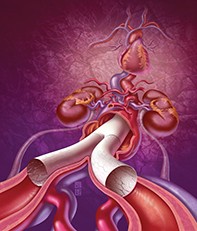Peer Reviewed
Feature Article Cardiovascular medicine
Advances in management of abdominal aortic aneurysms
Abstract
Management of abdominal aortic aneurysms is guided by aneurysm diameter and symptoms. Patients with small asymptomatic aneurysms require regular surveillance for aneurysm enlargement and risk factor control. Endovascular repair has become the treatment modality of choice for most patients with aneurysms above a threshold diameter.
Key Points
- Abdominal aortic aneurysms (AAAs) predominantly affect men aged over 65 years, with a prevalence of 10% in men aged over 80 years.
- AAA is the third most common cause of sudden death in older men, after myocardial infarction and stroke.
- Most AAAs are asymptomatic and are incidentally diagnosed.
- Medical management of cardiovascular risk factors, including use of antiplatelet agents and statins, is an important part of care.
- Endovascular aneurysm repair (EVAR) has become the modality of choice for repair of AAAs above a threshold diameter.
- EVAR has lower perioperative mortality and morbidity than open repair, but there is no difference in mid- and long-term mortality; EVAR is associated with more re-interventions and requires lifelong surveillance.
Picture credit: © KO Studios.

